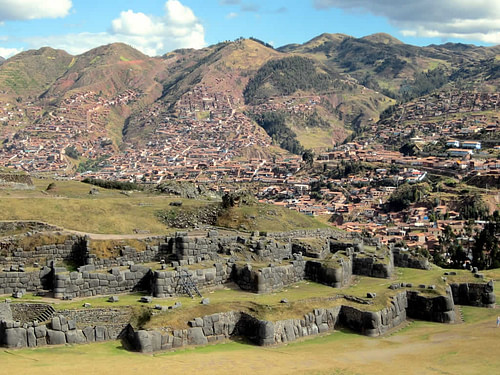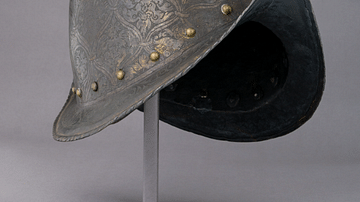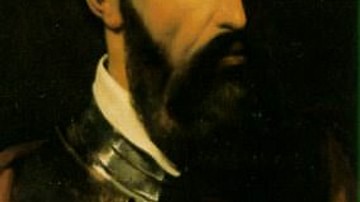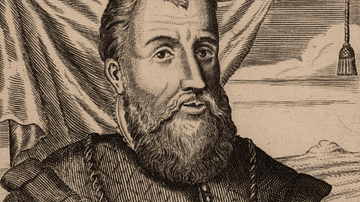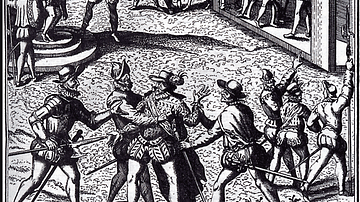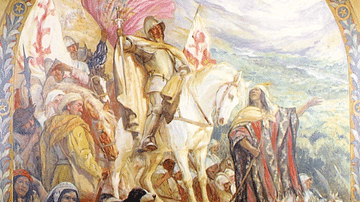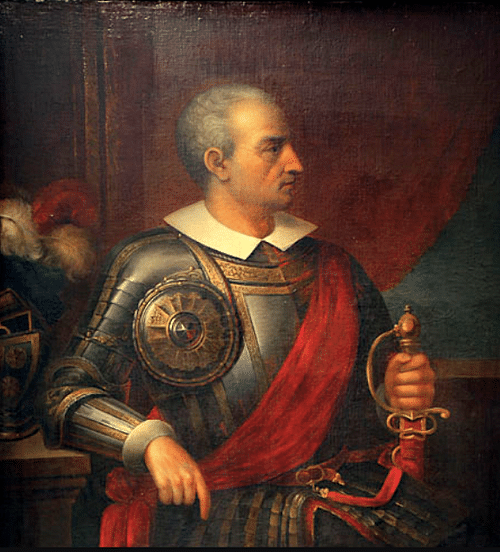
Diego de Almagro (c. 1475-1538) was a Spanish conquistador who was second-in-command to Francisco Pizarro (c. 1478-1541) during his expedition that attacked the Inca civilization from 1531. Almagro then led his own expedition to explore Chile but failed to find the golden cities he had hoped for. In the bitter and bloody rivalry that developed between conquistadors, Almagro was garotted in 1538.
Panama & Pizarro
Diego de Almagro was born in Almagro in the province of Extremadura, Spain, around 1475. He was born illegitimate, and so his chances of making much social progress were slim. Like many other young men in his position in this period and in this particular province, Diego lacked an education, he could neither read nor write, and so he looked to the sea for a way of escape and to find his fortune.
Diego was a member of the 1514 expedition to Panama led by Pedro Arias de Ávila (aka Pedrarias Dávila, b. 1442), a fellow conquistador who would later make a name for himself in the bloody business of conquest was Hernando de Soto (c. 1500-1542). In Panama, Almagro was given an encomienda, the right to exploit local resources and labour for his own use, and so he set up an estate near the capital Darien where he also tried his hand at gold prospecting. While in Panama Almagro met Francisco Pizarro, and the pair would join forces for three expeditions to South America, starting in 1524. The adventurers were keen to emulate their compatriot Hernán Cortés (1485-1547) in Mexico, who had conquered the Aztec civilization and gained a fortune. Almagro was skilled in logistics and recruitment, two essential areas for any expedition to unknown lands.
The historian C. Howard gives the following description of Almagro:
[He was] easygoing and lighthearted. He was short and far less noticeable [than Pizarro], except for the often gaudy clothes he favored. Unlike Pizarro, who could be quite eloquent at times, Almagro frequently had difficulty in expressing himself. Moreover, his face was disfigured by the loss of an eye, and his whole body carried scars of innumerable heroic campaigns. A little hasty and rather passionate in action, he was at one with the fighting ranks and was more understanding of his soldiers. (12)

A contemporary Spanish chronicler was a little harsher in his character description of Almagro:
[he was] a man of short stature, with ugly features, but with great courage and endurance. He was generous, but was conceited and was given to boasting, letting his tongue run on sometimes without stop…[he was] born of such humble parentage that one could say his lineage began and ended with himself.
(Sheppard, 84)
The 1st & 2nd Expeditions South
The 1524-5 expedition explored the northern coast of South America and attempted to sail up the Biru River but could make little headway against difficult winds and currents. The group then met a hostile tribe at Punta Quemado, where Pizarro received seven wounds, and a number of his men were killed. It was on this first expedition that Almagro lost his eye to a native javelin.
Undeterred, Pizarro and Almagro launched another expedition to the region in March 1526. Sailing to the San Juan River, Pizarro marched inland but was this time blocked by swamps. Meanwhile, Almagro returned to Panama for more supplies and Pizarro's pilot, Bartolomé Ruiz, sailed across the equator (the first European to do so in the Pacific), where he came across a balsa raft loaded with trade goods, including gold artefacts. At last, the conquistadors had positive proof that riches could be theirs if only they could find the source. Ignoring orders from the governor to return to Panama, Pizarro kept a volunteer force and sailed on to the Gulf of Guayaquil (where the coasts of Ecuador and Peru meet). There he discovered the bustling port of Tumbes. Here was further evidence of the presence of a great civilization and that there really was something in South America worth going after.

The 3rd Expedition South
In July 1529, Pizarro travelled home to Spain, and his purpose was rewarded when he received the coveted status of adelantado, which was the legal right given by the King of Spain, Charles V, Holy Roman Emperor (r. 1519-1556), to become the governor of any new lands he colonised on his expedition south. Pizarro organised his third expedition throughout 1530, and he set off once more into the unknown in December. The expedition, consisting of two caravel ships, sailed down the coast of Colombia and Ecuador. Pizarro led fewer than 200 fighting men to the Andes. Once again, his second-in-command was Diego de Almagro, although he followed behind after being tasked with a final recruitment drive for extra conquistadors in Panama.
Almagro had only received the rather disappointing title of Commander of the Fortress of Tumbes from the emperor. It was the beginning of a rift between Almagro and Pizarro, with the former thinking the latter had, during his time at court, only been looking after himself. The rift was temporarily patched when the long-time financial backer of the two conquistadors, Hernando de Luque, made Pizarro promise he would petition the emperor to have Almagro granted an area of the planned conquest to govern himself. It was also agreed that Pizarro would not promote his own family members above Almagro and that any riches from the conquest would be divided between the three men equally.
In November 1532, Pizarro made direct contact with the Incas. Their ruler Atahualpa was captured, and a great treasure accumulated as his ransom, literally tons of gold and silver. As Almagro arrived after this ransom had been divided, he and his men got very little of this great treasure. Cusco, the Inca capital, fell into Spanish hands in November 1533. Although vast in size, the relatively small Inca ruling elite, already weakened by a damaging civil war and European diseases which had arrived from Central America before the Spanish themselves had arrived, could not win a war against cavalry and steel and gunpowder weapons.
Facing Alvarado
Pizarro and Almagro's plan to carve up Peru for themselves was dealt an early blow in February 1534 when the utterly ruthless Pedro de Alvarado (c. 1485-1541) turned up on the coast of Ecuador with a fleet of 12 ships, 500 conquistadors, and 4,000 conscripted porters. Alvarado had become the governor of Guatemala, and he was keen to see what he could grab of the collapsing Inca Empire. Unwisely, Alvarado decided to cross the Andes, and by the time he managed that almost impossible feat, he had hardly any men or horses left. Pizarro had got wind of this expedition and sent Almagro to make sure no third conquistador muscled in on what they considered their own private conquest. At Quito, Almagro joined up with another conquistador force led by Sebastián de Belalcázar, and they awaited Alvarado's exhausted arrival. Unable to put up a fight, Alvarado was happy enough to accept a load of silver bullion for a promise to return immediately to Guatemala.
Expedition to Chile
Pizarro made Almagro the governor of Cusco in January 1535. Pizarro, meanwhile, headed to the coast where he established Ciudad de Los Reyes (Lima) in January 1535. Charles V now decided that his vast new colony in South America should be split between Pizarro and Almagro, with the former taking the northern half and Almagro the southern half. Just who controlled Cusco in this plan – located roughly in the middle – was left dangerously unclear. As a consequence of his new right to half the colony, Almagro left Cusco in July 1535 to explore what is today Chile and what became known to the Spanish as New Toledo. Cortés had plundered the wealth of the Aztecs, Pizarro that of the Incas, now, Almagro hoped to find his own gold-rich culture to relieve it of its wealth. Almagro's expedition was a sizeable one, and he commanded around 600 Spaniards, 1,000 Indian allies, and 100 African slaves.
Over a period of 20 months, Almagro took his men through what is today Bolivia and northern Argentina to reach Chile. The land was dry, harsh, and singularly lacking in gold. The conquistador established a base in the Aconcagua valley and sent out smaller expeditions in multiple directions. Almagro's men suffered the tortures of crossing Bolivia's Altiplano, fruitlessly roaming deep into Chile and then coming off worst, just as the Inca armies had done, against the Mapuche people. Elsewhere, local people were forcibly recruited to replace those porters who had died along the way. The Spaniards had also to face the desolation of the Atacama desert – the driest in the world – on their way back north. Most of Almagro's horses died during the trip and a good number of his men, too. The death toll of indigenous people taken along as slaves but who died in transit goes unrecorded.
It seemed to Almagro that, after all, the best source of silver and gold was Cusco, although this was not true since there lay to the south, in present-day Bolivia, the greatest untapped silver mine in the world at Potosí; the mountain would wait a little longer to give up its treasures to the conquistadors.
Back to Cusco
Meanwhile, it transpired that the Incas were not entirely done with Cusco themselves. Pizarro's puppet Inca ruler, Manco Inca Yupanqui (c. 1516-1544), led an uprising and attempted to take over the Inca capital. The subsequent siege of Cusco in 1536-7 was a closely-fought battle. Only with a relief column (the third such attempt) sent by Pizarro from Lima and the coincidental return of Almagro and his still-impressive force of 400 men could the Spanish hope to regain control of the Inca capital and free it from the siege. Almagro, though, grasped this situation to finally get his hands on the city he had once been appointed governor of and which he still considered in his half of Peru.
On 8 April 1537, Almagro sent a message to the Spanish commander of the city, Hernando Pizarro, Francisco's brother. The pair already had a long history of mutual dislike. Almagro called for Hernando to hand over Cusco to him. Hernando refused. A temporary truce arranged by magistrates was held between the two conquistador armies, but when Almagro heard that Pizarro's relief column would arrive imminently, he took drastic action and marched into the city. On 18 July, a body of Almagro's men torched Hernando's quarters and arrested him. Some of the Almagristas (aka Men of Chile) wanted to execute Hernando and his brother Gonzalo Pizarro who had also been imprisoned, but Almagro thought this was going too far.
In July, the relief column sent by Pizarro arrived at Cusco. Almagro led his army out to meet it, bunching his force around a crucial bridge of the Abancay River. Thanks to a traitor on the side of Pizarro's men, Almagro won the battle; it seemed Cusco was finally his. Pizarro must have been disappointed by the reversal, but he bided his time and gathered another strong army, one which was constantly being replenished by new arrivals from the Spanish Caribbean. Impatient to finally settle his old rivalry, Almagro marched his army to Lima, his trump card being his prisoner, Hernando Pizarro. Francisco Pizarro was willing to negotiate his way out of the problem; he offered a solution: Almagro could keep Cusco until the emperor decided the matter, and Hernando would be released but then banished from Peru. Almagro agreed. Almagro's generosity was not appreciated by his second-in-command, Rodrigo Orgóñez, who warned his chief of the danger of a free Hernando: "Your lordship has let the bull loose. He will attack you and kill you without respect for the fulfilment of his word and his oath" (Thomas, 278). Francisco Pizarro, with his brother now safe, promptly went back on his word and declared that Almagro would now have to fight if he wanted to keep Cusco.
The two forces of conquistadors, both led by second-in-commands since Pizarro and Amalgro were now too old and frail for battle duties, clashed outside Cusco on 26 April 1538. The bloody battle, watched with fascination by the Incas, became known as the Battle of Las Salinas because it happened near a local salt mine. The result of the clash of gunpowder weapons, pikes, and swords, went in favour of the Pizarros, but around 200 Spaniards died on each side.
Death & Discord
As Hernando Pizarro reestablished himself as governor of Cusco, he ordered the trial on the charge of treason and then the execution of Almagro. On 8 July 1538, Diego de Almagro was strangled in his prison cell, after which his corpse was taken to the public square where it was decapitated. Almagro was buried in the largest church of Cusco.
Francisco Pizarro was furious when he discovered these events. The Spanish Crown did not take too kindly to one of its adelantados being murdered either, and as soon as he landed back in Spain in 1539, Hernando Pizarro was imprisoned for the next 20 years. Back in South America, Almagro's family and supporters were now outcasts and found themselves no better off in the colony than newcomers from Europe, thanks to Francisco Pizarro's policy of favouring his own family members. This nepotism would prove to be a costly mistake, though. On 26 June 1541, Pizarro was stabbed to death in his home by a group loyal to Almagro; the group of assassins included Almagro's son, Diego de Almagro the Younger. The Pizarro-Almagro family feud rumbled on into the next generation. Gonzalo Pizarro (1506-1548) named himself his brother Francisco's successor and so became the governor of Peru, but Almagro's son still claimed rights over Cusco. The stalemate was not finally resolved until September 1542 and the arrival of Cristóbal Vaca de Castro with orders from Spain that he take up the position as governor of Peru, but even then the infighting rumbled on until the Spanish Crown took full control of its colony in 1554.

